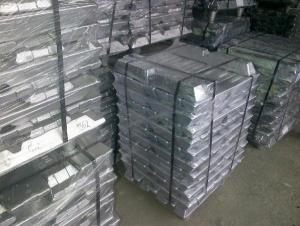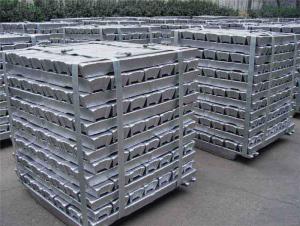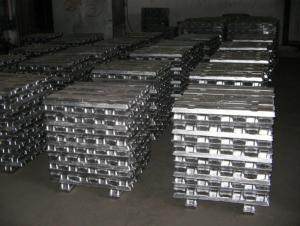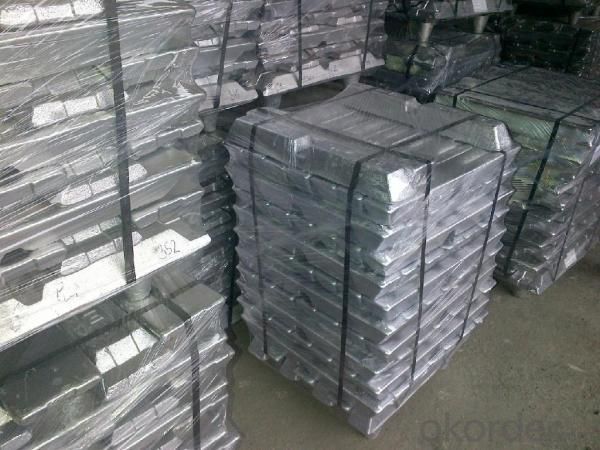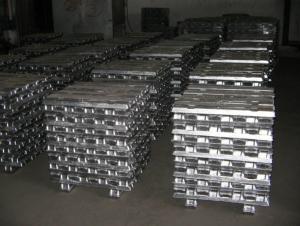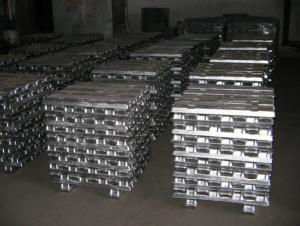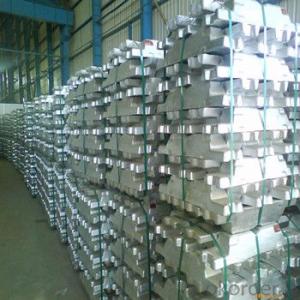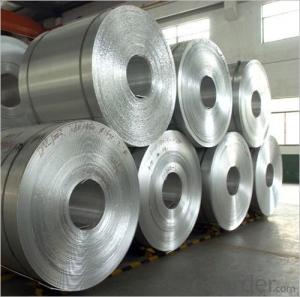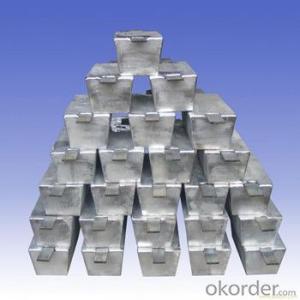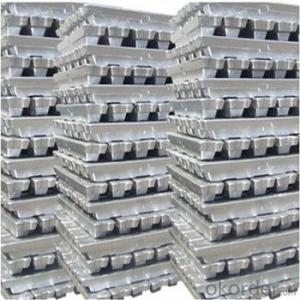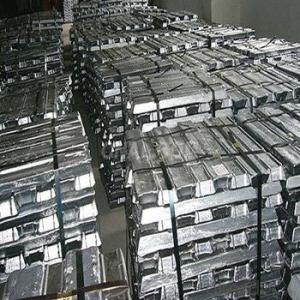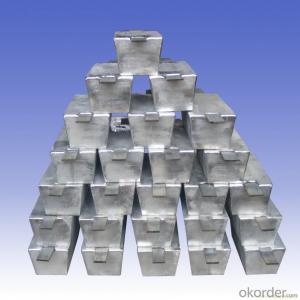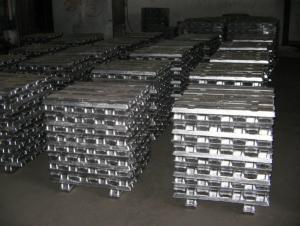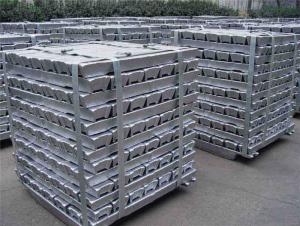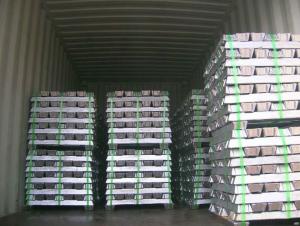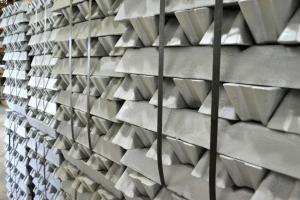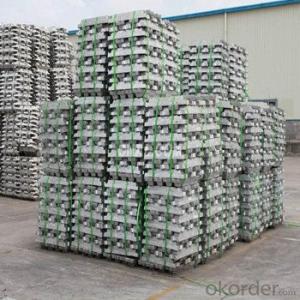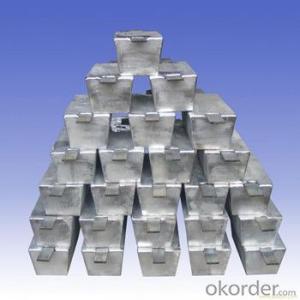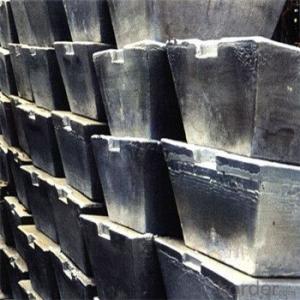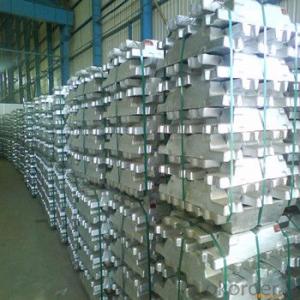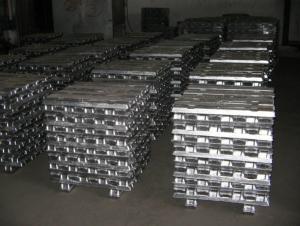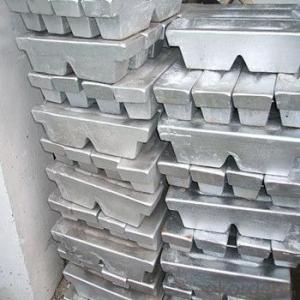Aluminum Ingots AA1070
- Loading Port:
- Shanghai
- Payment Terms:
- TT or LC
- Min Order Qty:
- 20 Tons m.t.
- Supply Capability:
- 1000 Sets Per Month m.t./month
OKorder Service Pledge
OKorder Financial Service
You Might Also Like
1. Specifications of Aluminum Ingots AA1070
Product Name | Aluminum Ingot |
Chemical Composition | Al |
Weight | 20/25kg |
Al (Min) | 99%-99.9% |
Appearance | silvery white |
Advantages | easy control and operation, fast melting |
Chemical Composition of Aluminum Ingots AA1070:
Grade | Chemical Composition % | |||||||||
Al≥ | impurities ≤ | |||||||||
Si | Fe | Cu | Ga | Mg | Zn | Mn | others | Sum | ||
Al99.9 | 99.90 | 0.50 | 0.07 | 0.005 | 0.02 | 0.01 | 0.025 | - | 0.010 | 0.10 |
Al99.85 | 99.85 | 0.80 | 0.12 | 0.005 | 0.03 | 0.02 | 0.030 | - | 0.015 | 0.15 |
Al99.7 | 99.70 | 0.10 | 0.20 | 0.010 | 0.03 | 0.02 | 0.030 | - | 0.030 | 0.30 |
Al99.6 | 99.60 | 0.16 | 0.25 | 0.010 | 0.03 | 0.03 | 0.030 | - | 0.030 | 0.40 |
Al99.5 | 99.50 | 0.22 | 0.30 | 0.020 | 0.03 | 0.05 | 0.050 | - | 0.030 | 0.50 |
Al99.00 | 99.00 | 0.42 | 0.50 | 0.020 | 0.03 | 0.05 | 0.050 | - | 0.050 | 1.00 |
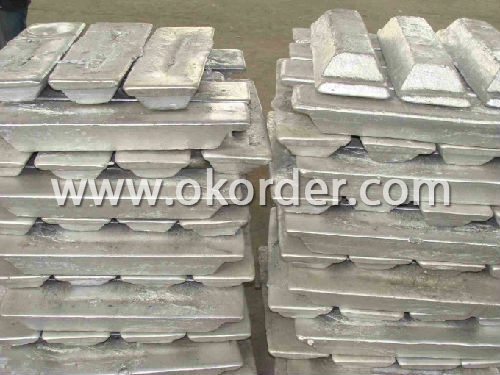
2. Usage/Application of Aluminum Ingots AA1070
1. mainly used for melting ingot
2. discontinuous melting with scrap
3. easy control and operation
4. fast melting
5. Used for industry such as automobile,pinning and weaving,electron broadly and so on
3.Packaging & Delivery of Aluminum Ingots AA1070
About 25Kg /Ingot, Packed in wooden case, Net weight 1000Kg/ Case, or as customer's requirements.
(1)Standard seaworthy export packing, wooden pallets with plastics protection for the coil and sheet. (2)15-20MT can be loaded into 20 foot container, we try to use 20 foot container, and the sea freight rate is much cheaper than 40 foot container. (3) The other packing can be made based on the customer requirement. (4) The packing is very strong, which has 3 lays, thick fiber, and foam, plastic. The bottom is wooden pallets
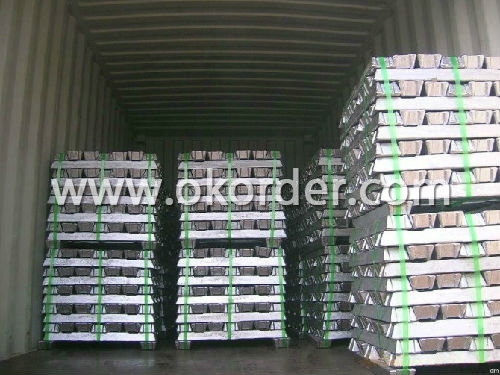
- Q: How are impurities removed from aluminum ingots during production?
- Impurities are removed from aluminum ingots during production through a process called refining. This involves melting the ingots and adding various fluxes or chemicals to remove impurities like iron, silicon, and copper. The impurities either react with the fluxes and form slag, which floats on top and is removed, or they form a dross layer that is skimmed off. Additionally, filtration techniques may be used to remove any remaining solid impurities.
- Q: How are aluminum ingots used in the production of signage?
- Aluminum ingots are used in the production of signage as they can be easily melted and cast into various shapes and sizes. These ingots serve as the raw material for manufacturing aluminum sign panels, frames, and other components. The lightweight and corrosion-resistant properties of aluminum make it an ideal choice for outdoor signage, as it can withstand harsh weather conditions without deteriorating. Additionally, aluminum ingots can be easily stamped, embossed, or engraved to create customized designs and lettering on signage, offering flexibility and versatility in the production process.
- Q: What is the role of aluminum ingots in the production of aircraft engines?
- Aluminum ingots play a crucial role in the production of aircraft engines as they are used to manufacture various engine components. Aluminum, being lightweight and possessing excellent thermal conductivity and corrosion resistance, is an ideal material for aircraft engines. The ingots are melted and cast into different shapes to create parts such as engine casings, pistons, cylinder heads, and other structural components. These ingots provide strength and durability while helping to reduce the overall weight of the engine, resulting in improved fuel efficiency and performance of the aircraft.
- Q: What are the advantages of using aluminum ingots in the production of aircraft structures?
- There are several advantages of using aluminum ingots in the production of aircraft structures. Firstly, aluminum is lightweight, which helps to reduce the overall weight of the aircraft. This, in turn, improves fuel efficiency and reduces operating costs. Secondly, aluminum has excellent corrosion resistance, ensuring the longevity and durability of the aircraft structures. Additionally, aluminum is easily formable and weldable, allowing for complex and intricate designs to be achieved. Lastly, aluminum is abundantly available and cost-effective, making it a preferred choice for aircraft manufacturers.
- Q: What type of spectrometer is used to analyze aluminium ingots?
- The spectrometer has many brands and many models, so you can't ask questions like that.
- Q: And aluminum liquid aluminum ingot related industries?
- There are two main methods for industrial preparation of aluminum chloride, aluminum and alumina powder method.
- Q: How about aluminium material?
- In the aluminum industry for more than ten years, from bauxite to aluminum ingots, aluminum bars, profiles are relatively ripe.
- Q: How do aluminum ingots compare to other metals in terms of strength?
- Aluminum ingots have different strength characteristics compared to other metals. Generally, aluminum is not as strong as some other metals, such as steel or titanium. However, it still possesses a good strength-to-weight ratio, making it suitable for a wide range of applications. The strength of aluminum ingots can vary depending on the alloy used and the manufacturing process. Aluminum alloys can be heat treated to increase their strength, but even in their natural state, they exhibit satisfactory strength properties. Furthermore, aluminum ingots have excellent corrosion resistance, which makes them highly desirable for applications in industries such as aerospace, automotive, construction, and packaging. Consequently, while aluminum may not possess the same level of strength as some other metals, its unique combination of properties still makes it a valuable material in various industries.
- Q: What are the different methods for machining aluminum ingots?
- There are several different methods for machining aluminum ingots, depending on the desired shape, size, and accuracy required for the final product. Some of the common methods include: 1. Milling: This is a process where a rotating cutter removes material from the ingot to create the desired shape. It is suitable for creating flat surfaces, slots, and holes. 2. Turning: In this method, the ingot is rotated while a cutting tool removes material to create cylindrical shapes. Turning can be used to create shafts, rods, and other cylindrical components. 3. Drilling: Drilling is a process where a rotating tool with cutting edges is used to create holes in the aluminum ingot. It is commonly used to create holes of various sizes and depths. 4. Grinding: Grinding involves using abrasive wheels or belts to remove material from the ingot's surface, creating a smooth and precise finish. It is often used to achieve tight tolerances and precise dimensions. 5. Sawing: Sawing is a process where a saw blade cuts through the aluminum ingot to create desired shapes or separate the ingot into smaller pieces. It is commonly used for cutting aluminum ingots into bars or smaller billets. 6. Waterjet cutting: Waterjet cutting uses a high-pressure stream of water mixed with abrasive particles to cut through the aluminum ingot. This method can create complex shapes and does not generate heat, making it suitable for cutting delicate or heat-sensitive materials. 7. Electrical discharge machining (EDM): EDM is a process that uses electrical sparks to remove metal from the aluminum ingot. This method is often used for intricate or detailed shapes that are difficult to achieve with conventional machining methods. It is important to select the appropriate machining method based on the specific requirements of the aluminum ingot and the desired final product. Factors such as the ingot's size, shape complexity, tolerance requirements, and material characteristics will influence the choice of machining method.
- Q: How are aluminum ingots used in the production of railway components?
- Aluminum ingots play a crucial role in the production of railway components due to their unique properties and benefits. These ingots are melted down and used as raw material for manufacturing various railway parts. One primary application of aluminum ingots in railway components is in the construction of lightweight yet durable train bodies. Aluminum has a high strength-to-weight ratio, which makes it an ideal material for building train carriages and panels. By using aluminum ingots, manufacturers can create lightweight structures that are easier to transport and require less energy to operate. This not only reduces fuel consumption but also contributes to a more sustainable and eco-friendly transportation system. Additionally, aluminum ingots are used for producing various other railway components such as doors, windows, and flooring. These components need to be strong, corrosion-resistant, and capable of withstanding the harsh environmental conditions experienced in railway operations. Aluminum, being highly resistant to corrosion, offers superior protection against weathering, ensuring the longevity and reliability of these components. Moreover, aluminum ingots are also used in the production of electrical components for railways. Aluminum's excellent electrical conductivity makes it suitable for manufacturing overhead power lines, conductor rails, and electrical connectors. These components are essential for ensuring efficient power transmission and distribution throughout the railway system. In conclusion, aluminum ingots are integral to the production of railway components. Their lightweight nature, strength, corrosion resistance, and electrical conductivity make them ideal for manufacturing train bodies, doors, windows, flooring, and electrical components. By utilizing aluminum ingots, the railway industry can achieve improved efficiency, durability, and sustainability in their operations.
1. Manufacturer Overview
| Location | Henan,China |
| Year Established | 1993 |
| Annual Output Value | Above US$200 Million |
| Main Markets | Mid East;Eastern Europe;North America |
| Company Certifications | ISO 9001:2000;ISO 14001:2004;OHSAS 18001 |
2. Manufacturer Certificates
| a) Certification Name | |
| Range | |
| Reference | |
| Validity Period |
3. Manufacturer Capability
| a) Trade Capacity | |
| Nearest Port | Shanghai |
| Export Percentage | 30%-50% |
| No.of Employees in Trade Department | 21-50 People |
| Language Spoken: | English;Chinese |
| b) Factory Information | |
| Factory Size: | Above 100,000 square meters |
| No. of Production Lines | Above 10 |
| Contract Manufacturing | OEM Service Offered;Design Service Offered |
| Product Price Range | Average |
Send your message to us
Aluminum Ingots AA1070
- Loading Port:
- Shanghai
- Payment Terms:
- TT or LC
- Min Order Qty:
- 20 Tons m.t.
- Supply Capability:
- 1000 Sets Per Month m.t./month
OKorder Service Pledge
OKorder Financial Service
Similar products
Hot products
Hot Searches
Related keywords
